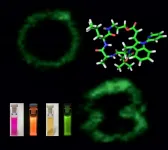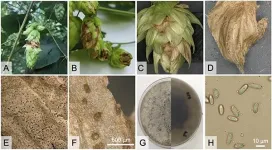Clever biomolecular labelling enables identification of immune cells
Research team led by the University of Göttingen develops new strategy for labelling peptides
2021-06-07
(Press-News.org) Biomolecules regulate the biological functions inside every living cell. If scientists can understand the molecular mechanisms of such functions, then it is possible to detect the severe dysfunction which can lead to illness. At a molecular level, this can be achieved with fluorescent markers that are specifically incorporated into the respective biomolecules. In the past, this has been achieved by incorporating a marker in the bio-molecule by completely rebuilding it from the beginning, necessitating a large number of steps. Unfortunate-ly, this approach not only takes a lot of time and resources, but also produces unwanted waste products. Researchers at the Universities of Göttingen and Edinburgh have now been able to show that a non-toxic complex of the common metal manganese makes it possible to conveniently label a class of special bio-molecules known as peptides right at the last minute of their synthesis. This means the mechanism of action of these labelled peptides can be investigated efficiently. The results were published in the journal Nature Communications.
The research group developed the selective labelling of peptides and natural biological products at a late point in the series of steps necessary for synthesis by activating carbon-hydrogen bonds in tryptophan residues. This experimentally simple strategy makes it possible to efficiently access novel fluorescent pep-tides that are highly sensitive to their biological environment. This enabled the team to create a highly sensi-tive "rotor" with the ability to show changes in the composition of membranes of immune cells. Its fluores-cence is dependent on the viscosity of the cell membrane. The researchers observed radiant fluorescence in the presence of cholesterol in the cell membrane. In this way, the rotor can be used to screen certain mole-cules in cells that are important for the adaptive immune system to fight infections and cancer.
"The project demonstrates the power of combining chemical, biological and medical research, which allows the direct observation of cell-specific events," says project leader Professor Lutz Ackermann from Göttin-gen University. "Furthermore, the successful collaboration ensures our discoveries to have an immediate impact not only in the field of chemistry, but also in the biomedical sciences. Sharing ideas and expertise between the teams enabled a joint approach to real-life problems."
INFORMATION:
Original publication: Nikolaus Kaplaneris et al. Chemodivergent manganese-catalyzed C-H activation: modu-lar synthesis of fluorogenic probes. Nature Communications (2021). Doi: 10.1038/s41467-021-23462-9. Full text also available here: https://rdcu.be/cl4iz
Contact:
Professor Lutz Ackermann
University of Göttingen
Institute of Organic and Biomolecular Chemistry
Tammannstrasse 2, 37077 Göttingen, Germany
Tel: +49 (0)551 39-33202
Email: Lutz.Ackermann@chemie.uni-goettingen.de
http://www.ackermann.chemie.uni-goettingen.de
[Attachments] See images for this press release:

ELSE PRESS RELEASES FROM THIS DATE:
2021-06-07
If you're a beer drinker, you've noticed that hoppy beers have become increasingly popular. Most of the nation's hops come from the Pacific Northwest. However, commercial hop production regions have expanded significantly. In Michigan hop production nearly tripled between 2014 and 2017 and in 2019, Michigan growers harvested around 720 acres of hops.
Michigan hop growers contend with unique challenges as a result of frequent rainfall and high humidity during the growing season. In 2018, growers approached Michigan State University researchers and the Michigan State University's Plant & Pest Diagnostics lab with concerns about a leaf blight ...
2021-06-07
ORLANDO, June 2021 - A new study co-authored by University of Central Florida researchers shows that pre-Columbian people of a culturally diverse but not well-documented area of the Amazon in South America significantly altered their landscape thousands of years earlier than previously thought.
The findings, published in the journal Proceedings of the National Academy of Sciences, show evidence of people using fire and improving their landscape for farming and fishing more than 3,500 years ago. This counters the often-held notion of a pristine Amazon during pre-Columbian times before the arrival of Europeans in the late 1400s.
The study, ...
2021-06-07
Climate change and social inequality are two pressing issues that often overlap. A new study led by Princeton researchers offers a roadmap for cities to address inequalities in energy use by providing fine-grained methods for measuring both income and racial disparities in energy use intensity. Energy use intensity, the amount of energy used per unit floor area, is often used as a proxy for assessing the efficiency of buildings and the upgrades they receive over time. The work could guide the equitable distribution of rebates and other measures that decrease energy costs and increase efficiency.
Examining inequality in cities has been hampered ...
2021-06-07
"The big mystery about plankton is what controls its distribution and abundance, and what conditions lead to big plankton blooms," said Dennis McGillicuddy, Senior Scientist and Department Chair in Applied Ocean Physics and Engineering at the Woods Hole Oceanographic Institution (WHOI).
Two new papers explore this question and provide examples of conditions that lead to massive plankton blooms with vastly different potential impacts on the ecosystem, according to McGillicuddy, co-author of both papers. Both papers also point to the importance of using advanced technology--including Video Plankton Recorders, autonomous underwater vehicles, and the Ocean Observatories Initiative's Coastal Pioneer Array--to find and monitor these blooms.
In one paper, Diatom Hotspots Driven ...
2021-06-07
Key Takeaways:
Study finds non-tiered customer loyalty programs create a more sustainable customer base.
Non-tiered customer loyalty programs are not as likely to generate increases in spending per transaction or accelerate transactions.
CATONSVILLE, MD, June 7, 2021 - Customer loyalty programs have been around for decades and are used to help businesses, marketers and sellers build a sustainable relationship with their customers. But do they work? A recent study sought to find out and researchers learned that while yes, customer loyalty programs do work, perhaps not in ways most may assume.
There are two basic ...
2021-06-07
LA JOLLA--(June 7, 2021) Type 1 diabetes, which arises when the pancreas doesn't create enough insulin to control levels of glucose in the blood, is a disease that currently has no cure and is difficult for most patients to manage. Scientists at the Salk Institute are developing a promising approach for treating it: using stem cells to create insulin-producing cells (called beta cells) that could replace nonfunctional pancreatic cells.
In a study published on June 7, 2021, in the journal Nature Communications, the investigators reported that they have developed a new way to create beta cells that is much more efficient than previous methods. Additionally, when these beta cells were tested in a mouse model of type 1 diabetes, ...
2021-06-07
WHAT:
New findings published in JAMA Neurology suggest there is no difference in cognitive outcomes at age 2 among children of healthy women and children of women with epilepsy who took antiseizure medication during pregnancy. The findings are part of the large research project Maternal Outcomes and Neurodevelopmental Effects of Antiepileptic Drugs (MONEAD), which is a prospective, long-term study looking at outcomes in pregnant women with epilepsy and their children. The study was funded by the National Institute of Neurological Disorders and Stroke (NINDS), part of the National Institutes of Health. ...
2021-06-07
Youth brain activation data from the largest longitudinal neuroimaging study to date provides valuable new information on the cognitive processes and brain systems that underlie adolescent development and might contribute to mental and physical health challenges in adulthood. The study published today online in END ...
2021-06-07
Artificial intelligence natural language computer applications are becoming increasingly sophisticated, raising the possibility that they could assume a greater role in health care, including interacting with patients. But before these applications enter the clinic, their potential and pitfalls need thoughtful exploration, states a new article in NPJ Digital Medicine.
The authors are Diane M. Korngiebel, a Hastings Center research scholar, and Sean D. Mooney, chief research information officer at University of Washington Medicine.
"There is compelling promise and serious hype in AI applications that generate natural language" Korngiebel and Mooney write, referring to OpenAI's Generative Pre-trained Transformer 3 (GPT-3) ...
2021-06-07
LEBANON, NH - Previous work by a team of researchers led by Steven N. Fiering, PhD, Immunology and Cancer Immunotherapy researcher at Dartmouth's and Dartmouth-Hitchcock's Norris Cotton Cancer Center and Nicole Steinmetz, PhD, Jacobs School of Engineering and Moores Cancer Center, University of California San Diego, showed that a plant virus that does not infect mammals, cowpea mosaic plant virus (CPMV), when injected into cancerous tumors, strongly stimulated the immune system to attack and often eliminate the tumor. However, very little was understood about immune recognition of plant viruses and how and why CPMV is exceptionally immuno-stimulating. In a new study, the team identifies ...
LAST 30 PRESS RELEASES:
[Press-News.org] Clever biomolecular labelling enables identification of immune cells
Research team led by the University of Göttingen develops new strategy for labelling peptides






